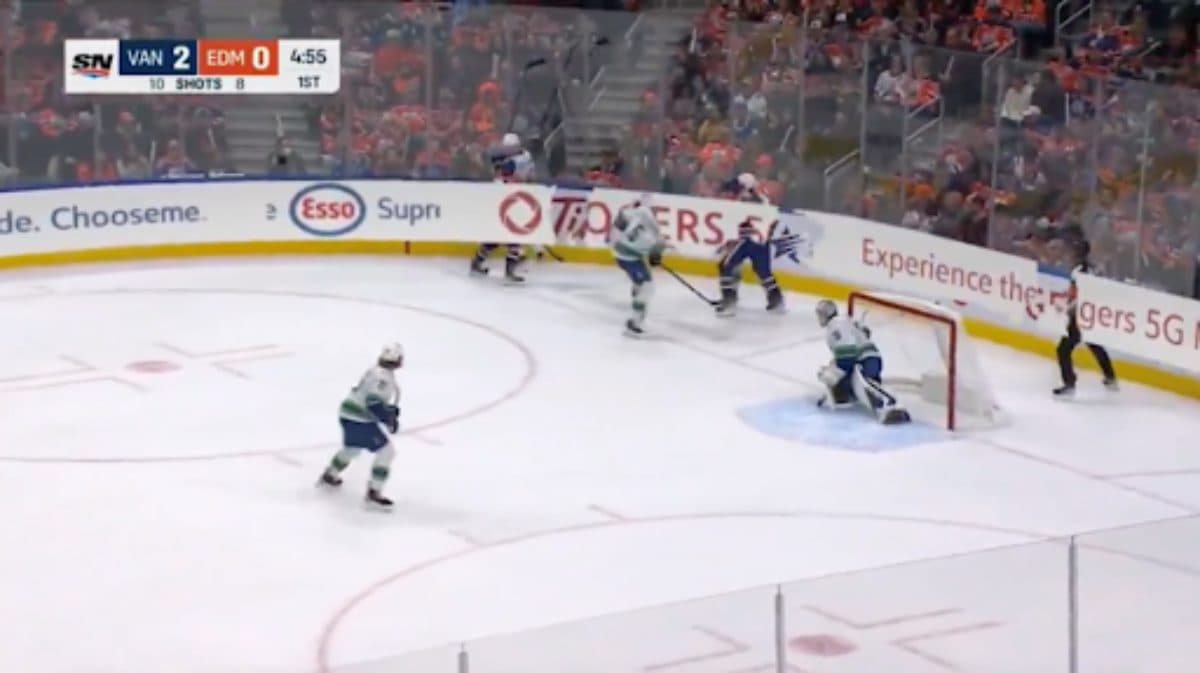NHL Digital Rink Board Advertisements Pose Health Concern for Certain Fans

This article was written by Dylan Nazareth, who is part of the Professional Hockey Writers Association x To Hockey With Love Mentorship Program. This program pairs aspiring writers with established members of the association across North America to create opportunities for marginalized people that do not traditionally get published on larger platforms covering hockey.
To Hockey With Love is a weekly newsletter covering a range of topics in hockey – from the scandals of the week to providing a critical analysis of the sport.
_____
Like many hockey fans in North America, Sebastian Jackson introduced his child to the NHL at a very young age. Jackson and his five-year-old daughter Sophia have been watching NHL games on television together for the past couple of seasons, but that family routine was suddenly halted this season.
On her fifth birthday, Sophia was diagnosed with epilepsy. In the past, Sophia’s condition would not have prevented her from watching NHL games on television. But thanks to the NHL’s decision to implement digital advertising on its rink boards on most of their television broadcasts this season, Sophia is now at risk of experiencing a seizure each time she tunes to watch a hockey game with her father.
“I wanted to show her some of the traditions that I had growing up. So we would watch every Saturday night, or I would let her stay up sometimes until 10:00, you know, until the end of the game,” says Jackson, who currently lives in Kitchener, Ontario. “But we had to abruptly put an end to that.”

Epilepsy is a neurological condition that affects approximately one in 100 Canadians. Of those one in 100, approximately three per cent of those people have photosensitive epilepsy, which means that they can have seizures triggered by such things as flashing lights or images.
This season’s implementation of digital rink board advertisements on television broadcasts has been one of the most controversial decisions by the league in the past few years. Many fans across North America seem to have an issue with the change, frequently taking to social media to complain about the repeated technical glitches that disrupt their viewing experience. But beyond being a nuisance, it may also be dangerous.
“The ads specifically have triggered a lot of symptoms that onset seizures,” explains Jackson. “When the play is along the boards… with the white ads along the side of the boards it is actually different lighting. So it can cause some triggers neurologically,” explains Jackson.
Earlier this year, CTV News aired a piece on this issue, but Jackson says since then “essentially nothing has happened.” The National Hockey League did not comment on that story, and has not addressed health and accessibility concerns with regards to the digital advertisements.
Since the CTV segment aired in January, Jackson has been able to connect with more people through social media who are affected by these advertisements. “I have interacted with about a hundred other people who these ads have triggered certain things like headaches. You know, other things that might lead up to a seizure,” he says. “I have interacted with people with epilepsy. A lot of people have had to stop watching.”
Despite the overwhelmingly positive response, Jackson also received a number of negative comments online. “Some people going so far as calling my daughter names and making fun of her. Somebody actually on Instagram sent a death threat to her.”
In general, he saw “a lot of ableist mindset,” with people questioning the legitimacy of his claims.
Unfortunately, this is to be expected with these kinds of issues, according to Director of Communications at Epilepsy Toronto Mackenzie Muldoon. “There is often a lot of stigma around epilepsy,” says Muldoon. “People don’t understand it. People are unaware how varied it can be.”
“In general, epilepsy is not talked about enough. In all its forms, epilepsy is underreported,” she says, and this can be attributed to a lack of understanding. Despite many people’s singular idea of what a seizure looks like, “There are so many different types of seizures that people have,” notes Muldoon. “Someone might be watching hockey and having what we call an absence seizure, which a lot of people described as looking like a daydream. No one would maybe even notice that they have had a seizure as a result.”
With regards to the advertisements, Muldoon says it is “certainly it is something that we would like to see corrected.” Some have suggested the NHL should implement a warning before broadcasts as a bare minimum gesture. “Everyone is familiar with the warnings for people when there is a strobe effect being used, everyone gets that,” comments Muldoon. “I don’t know why at least a warning couldn’t be put out.”
For the NHL, it seems it comes down to a question of money. Last year, ESPN reported that the development of these advertisements cost “tens of millions of dollars,” and allows increased revenue by selling more regional broadcasts and increasing the number of advertisements that are shown in a game.
Since they have invested so heavily and are projected to see increased profits, they may be reluctant to put out a warning because it would be an admission to their advertisers that the service they’re providing is failing consistently.
But Jackson doesn’t accept these excuses. “I really thought that when we are talking about dangerous situations for your consumers and the people buying your product, that they would care a little more than they have. We clearly see that they don’t care. As long as there is a price tag slapped on it, they fill their pockets and basically it’s like, well, we don’t care about your five year-old daughter.”
In a league filled with fierce competition and notorious rivalries, it seems one thing fans across all 32 franchises can agree on is that the digital board ads and their constant technical glitches are a major annoyance for those watching hockey.
Come next season, the NHL should think twice about continuing to use these advertisements.
As Muldoon concludes, “It would be great if everyone across Canada could enjoy the hockey game.”
_____
More from the PHWA x To Hockey With Love Mentorship Program
- Finding home away from home: Milwaukee’s Askarov and Afanasyev on the Russian experience playing in North America
- Brothers, Boy Bands, and Budding Talents: The rise of Taro and Akito Hirose
- The Outdoor Rats: The Rise of March & Mill Co.
- The Spectrum of Hockey: Elliotte Friedman’s window on Hockey is For Everyone
- ‘I’m sure he wanted to be a Cale Makar’: Inside the reinvention of T.J. Brodie
- Hard work pays off for Rafaël Harvey-Pinard
- ‘Representation counts’: Growing the game off the ice and in the booth
- Leafs’ Nick Robertson embraces opportunity to be a role model for next generation of Filipino players, fans
- Cole Caufield: Stevens Point’s Messi on Ice
- NHL’s new initiative focuses on improving outreach to Latino audience
- Breaking the ice: How a young woman’s childhood dream is pushing hockey in Brazil closer to reality
- ‘You can’t be just casual on these situations anymore’: A Q&A with Brock McGills and Kurtis Gabriel on hockey culture
- The Jim Benning/Travis Green firings, one year later: How much has changed for the Vancouver Canucks?